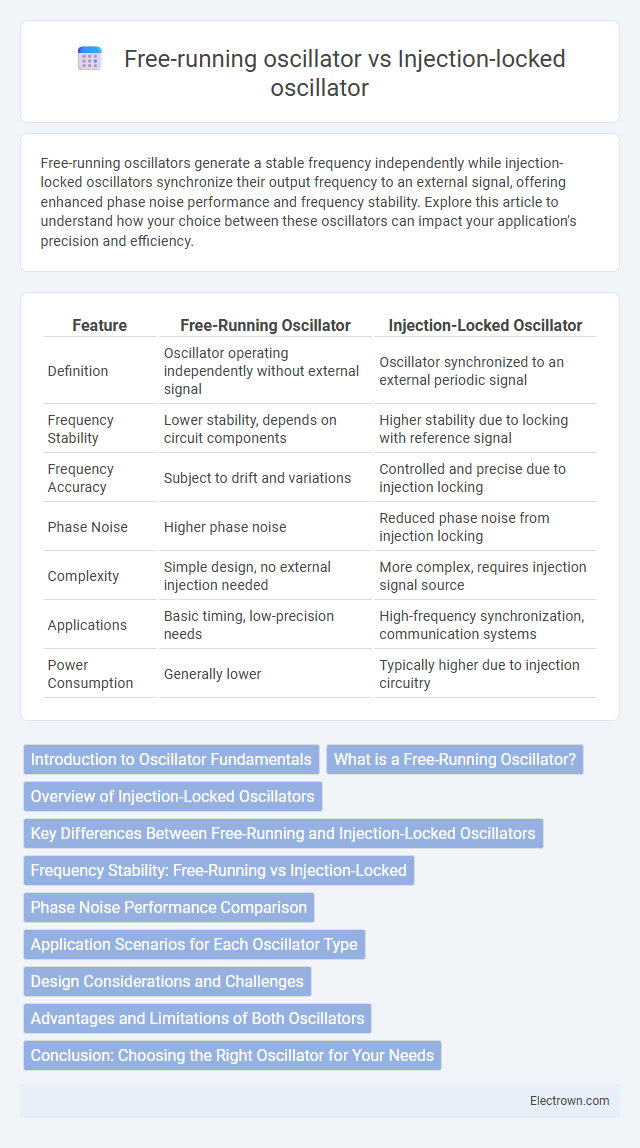Free-running oscillators generate a stable frequency independently while injection-locked oscillators synchronize their output frequency to an external signal, offering enhanced phase noise performance and frequency stability. Explore this article to understand how your choice between these oscillators can impact your application's precision and efficiency.
Table of Comparison
| Feature | Free-Running Oscillator | Injection-Locked Oscillator |
|---|---|---|
| Definition | Oscillator operating independently without external signal | Oscillator synchronized to an external periodic signal |
| Frequency Stability | Lower stability, depends on circuit components | Higher stability due to locking with reference signal |
| Frequency Accuracy | Subject to drift and variations | Controlled and precise due to injection locking |
| Phase Noise | Higher phase noise | Reduced phase noise from injection locking |
| Complexity | Simple design, no external injection needed | More complex, requires injection signal source |
| Applications | Basic timing, low-precision needs | High-frequency synchronization, communication systems |
| Power Consumption | Generally lower | Typically higher due to injection circuitry |
Introduction to Oscillator Fundamentals
Free-running oscillators generate consistent periodic signals based on internal resonators without external control, offering straightforward design and stable frequency outputs. Injection-locked oscillators enhance stability and reduce phase noise by synchronizing with an external reference signal, enabling precise frequency control. Both types rely on feedback mechanisms to sustain oscillations, but injection locking introduces an external influence that aligns oscillator phases for improved spectral purity.
What is a Free-Running Oscillator?
A free-running oscillator is an electronic circuit that generates a periodic signal at its natural resonant frequency without requiring any external synchronization. It operates based on internal components like inductors, capacitors, or crystals, maintaining stable oscillations determined by its inherent properties. This contrasts with injection-locked oscillators, which synchronize their output frequency to an external reference signal for enhanced accuracy and phase noise performance.
Overview of Injection-Locked Oscillators
Injection-locked oscillators (ILOs) synchronize their oscillation frequency to an external periodic signal, offering improved phase noise performance compared to free-running oscillators. They leverage the injection locking phenomenon, where a high-quality reference signal forces the oscillator to lock onto its frequency and phase. This mechanism enables ILOs to achieve enhanced frequency stability and reduced jitter, making them ideal for applications in communication systems and precision timing.
Key Differences Between Free-Running and Injection-Locked Oscillators
Free-running oscillators operate independently, generating a stable frequency solely determined by their internal components, whereas injection-locked oscillators synchronize their output frequency to an external signal through injection locking. Free-running oscillators typically exhibit higher phase noise and frequency drift compared to injection-locked oscillators, which benefit from reduced phase noise and improved frequency stability due to the locking mechanism. Injection-locked oscillators are preferred in applications requiring frequency coherence and synchronization, while free-running oscillators are advantageous for simplicity and autonomous operation.
Frequency Stability: Free-Running vs Injection-Locked
Free-running oscillators exhibit inherent frequency stability determined by their internal resonator and component quality, but they are susceptible to environmental variations like temperature and supply voltage changes. Injection-locked oscillators achieve enhanced frequency stability by synchronizing to an external reference signal, dramatically reducing phase noise and frequency drift. The injection-locking mechanism forces the oscillator to lock onto the injected signal frequency, providing superior spectral purity and improved long-term frequency accuracy compared to free-running counterparts.
Phase Noise Performance Comparison
Free-running oscillators typically exhibit higher phase noise due to their reliance on natural resonance without external synchronization, resulting in less frequency stability. Injection-locked oscillators achieve significantly lower phase noise by synchronizing their output frequency to a reference signal, reducing jitter and improving spectral purity. Your design choice depends on whether ultra-low phase noise or simplicity and autonomy of the oscillator are more critical for the application.
Application Scenarios for Each Oscillator Type
Free-running oscillators excel in applications requiring stable frequency generation without external synchronization, such as clock generation in microprocessors and RF signal sources. Injection-locked oscillators are ideal for scenarios demanding phase synchronization with an external reference, including phased array antennas, clock recovery circuits, and frequency synthesis. Your choice depends on whether independent frequency stability or precise phase locking is crucial for the system's performance.
Design Considerations and Challenges
Free-running oscillators offer design simplicity and frequency stability without external signals but face challenges like frequency drift due to temperature and process variations. Injection-locked oscillators improve frequency accuracy by synchronizing with an external reference, yet require careful design to manage locking range, injection strength, and phase noise degradation. Your choice depends on the application's tolerance for frequency stability, complexity, and power consumption constraints.
Advantages and Limitations of Both Oscillators
Free-running oscillators offer simplicity and stable frequency generation with minimal external control, making them ideal for standalone applications, but they suffer from frequency drift due to temperature and supply variations. Injection-locked oscillators provide superior frequency stability and phase noise performance by synchronizing to an external signal, enhancing your system's accuracy, yet they depend on the presence of a locking signal and have a limited locking range. Understanding these trade-offs helps optimize oscillator choice for applications requiring either autonomous operation or precise synchronization.
Conclusion: Choosing the Right Oscillator for Your Needs
Selecting between a free-running oscillator and an injection-locked oscillator depends on your specific application requirements such as frequency stability, phase noise, and power consumption. Free-running oscillators offer simplicity and independence from external signals, making them ideal for general-purpose use where slight frequency variation is acceptable. Injection-locked oscillators provide more precise frequency control and lower phase noise by synchronizing to an external reference, which benefits communications and high-performance RF systems.
Free-running oscillator vs injection-locked oscillator Infographic

 electrown.com
electrown.com